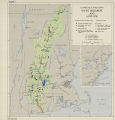| OCR Text |
Facilities in Construction and Authorized At the present time, two redevelopment projects by private utilities are going forward in the basin. New facilities providing an increase in capacity are under construction at Wilder and Holyoke. The Holyoke site will have an initial installation of 15,000 kilowatts (in addition to the existing 10,540- kilowatt installation), but an ultimate capacity of 60,000 kilowatts is contemplated. The Wilder site is being redeveloped to generate 33,000 kilowatts initially, with a possible ultimate installation 50 percent greater. No Federal electric power generating facility is under construction or authorized in the basin. Needs and Potentialities Existing in the Basin The utility systems in the power area, with about 3.5 million kilowatts installed capacity of which some 3.3 million kilowatts are dependable under adverse conditions, had a peak demand of 2.8 mil- lion kilowatts in December 1949. Power market studies by the Federal Power Commission indicate that an increase in the utility peak demand of some 2.5 million Jdlowatts to a total of about 5.3 million kilowatts is to be expected in the area by 1970. Taking into account the retirement of old and obsolete plants, it is estimated that capacity addi- tions totaling more than 3.5 million kilowatts will be required by that date in order to meet the fore- cast load. It appear-s, however, that there is no major pro- gram, either by the private utilities or the Fed- eral Government, for constructing new hydroelec- tric plants in the Connecticut or other river basins of the region to supply a significant portion of the power required. With undeveloped water power possibilities es- timated at about 950,000 kilowatts for the Con- necticut Rixrer Basin, and approximately 2.3 mil- lion kilowatts for other parts of New England, it is evident tliat a large part of the required new capacity, of the order of 3.5 million kilowatts for these five States by 1970, could be provided by additional hydroelectric plants in the area. How- ever, the hydroelectric potentialities of New Eng- land streanxs are more adaptable to development of peak load, purposes, and even if the undeveloped water power in Maine, estimated at about 1.6 mil- lion kilowatts exclusive of Passamaquoddy tidal power, were= used in this area, there still would be 476 need for new fuel-electric plants in the region.1 Hydroelectric power in New England has its greatest value when used in conjunction with base load power, such as will be provided by the St. Lawrence hydro or steam plants. These plants are well adapted to peak-load use for several reasons: (1) They may be put into operation in a shorter period of time than is required for steam-electric plants; (2) they generally are better suited for wider fluctuations in output to meet the load than other sources of power supply; and (3) for a given amount of dependable primary power at a hydro- electric site, the incremental cost of capacity to provide for low plant factor use is generally less than the cost of equivalent capacity in other types of plants. Hydroelectric units are also valuable as reserve units, saving the no-load fuel costs necessary to keep steam plants ready to serve. When hydroelectric units are not producing power, the generators may be used as synchronous condensers to improve the system power factor and thus improve the effi- ciency of generation and transmission. Full use of the water power resources in the Northeast, in- cluding New England and New York, would pro- vide both base load hydro and peaking supplements to that base load hydro and thermal generation. This would effect stability and economies in power system operation. Many investigations of the water power poten- tialities of the Connecticut and other river basins in New England have been made. Most of these have not been comprehensive. Extensive basin- wide surveys and investigations are necessary, therefore, to determine more precisely the eco- nomic feasibility of further developing hydroelec- tric power possibilities. Comprehensive basin-wide investigation should be made for all of the New England river systems to determine fully the poten- tialities for further hydroelectric power production, and the possibilities for other purposes including flood control and navigation. Such investigations should include the possibili- ties of integration of the power possibilities of this basin with those of Maine, northeastern New York, including the International Rapids Project on the St. Lawrence, and possibly the Niagara Falls de- velopment. The Flood Control Act of 1950 au- thorized the Corps of Engineers to make such 1 Actually Maine requirements could be expected to account for a significant part of production from Maine plants. |


























































































































































































































































































































































































































































































































































































































































































































































































































































